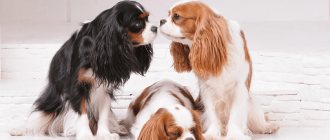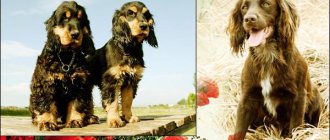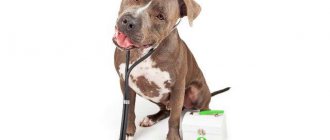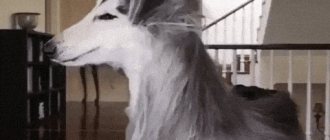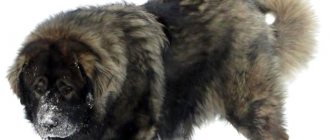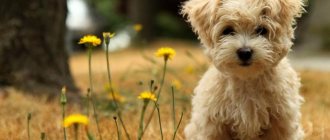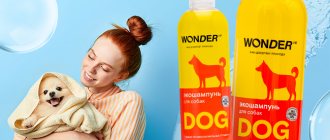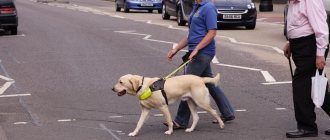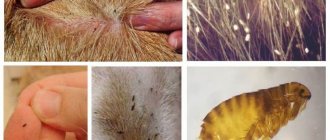Aboriginal breeds develop in close contact with local residents. This gives them the opportunity to better understand the person and adapt to his needs. The Kooikerhondje (Dutch Spaniel) is famous for its ability to anticipate the desires of the hunter. The Dutch are no less sensitive when it comes to their family. Kooikerhondje combines the functions of a hunter, watchman and companion.
Breed characteristics
| Short description | |
| Origin: | Netherlands |
| Conditions of detention: | House, apartment, local area (kennel) |
| Purpose: | Hunting dog, companion |
| Color: | White with large tan or reddish spots |
| Wool length: | Average |
| Adult dog size: | The height of the female is 38-40 cm, the male is 40-42 cm, weight is 9-11 kg |
| Average life expectancy: | 12-14 years old |
| Walk: | Twice active walking is required |
| Physical activity needs: | High physical activity needs (daily walks with vigorous exercise, participation in hunting or dog sports) |
| Fédération Cynologique Internationale (FIC) classification: | Group 8: Retrievers, Spaniels and Water Dogs; section 2: spaniels |
| Puppy price: | 30,000-60,000 rubles. Without pedigree - 30,000-35,000 rubles, pet class - up to 40,000 rubles, breed class - 45,000-50,000 rubles, show class - 60,000 rubles. |
Health and life expectancy
Kooikerhondje is one of the relatively healthy breeds. Most dogs do not suffer from hereditary diseases, have good immunity, and do not have digestive problems. But there are also those who are less fortunate. The list of the most common pathologies includes:
- von Willebrand's disease;
- Necrotizing myelopathy;
- Patella dislocation;
- Hip dysplasia;
- Eye diseases (cataracts, progressive retinal atrophy).
Other breed-specific diseases are relatively rare and cannot be detected by screening:
- Epilepsy;
- Polymyositis;
- Glomerular kidney diseases.
To maintain the health of Kooikerhondje, annual, lifelong vaccination and timely treatment against parasites are important. Every year, dogs are recommended to undergo a full medical examination in order to identify hidden pathologies in time. Life expectancy is usually 12-14 years.
History of the origin of the species
A real working dog: it will clean the house of rodents, bring game, and help the farm. According to official data, the breed appeared in the north of Holland at the end of the 16th century, but, according to historical references, these animals have been serving humans for more than 5 centuries.
One of the Spaniels was the favorite of William II of Orange. The dog woke up the monarch when he sensed the advance of the Spanish troops, which saved not only the prince, but the entire kingdom. After this incident, the breed became the official symbol of the Dutch kingdom. This is where the first name came from. “Koikerhondje” literally translates as “duck hunter”.
An interesting feature of the breed is its hunting style, tolling. Animals do not simply bring killed or shot game in their teeth, they lure it to the shore (into a built trap) by waving their tail. Only two species work this way - Nova Scotia Retrievers and Dutch Spaniels.
Due to the decline in the popularity of duck hunting, the number of animals has decreased. In 1942, work began to restore the species, and in 1966 the first standard was written. Spaniels have been officially recognized since 1971.
Relationships with people and animals
Kooikerhondje also doesn’t like children. He will get angry if some baby pulls his fur. Therefore, it is better not to leave them alone. But, you can be absolutely sure of the good-natured intentions of this beast.
Whatever his attitude towards a particular person, he will never harm him, that is, he will not bite. The breed has a high level of adaptation. Wherever you go with Kooikerhondje, he will feel comfortable next to you.
Distinctive features
This breed is a Spaniel, in the classical sense: an elongated, dry body, a long muzzle, hanging large ears with feathering, strong limbs. The peculiarity of the species is its stable color (white with red spots and black “earrings”). Representatives are slightly smaller than their English counterparts (at the withers no more than 42 cm, weigh up to 11 kg).
- The head is dry and elongated. The forehead is wide with a soft groove, the skull is rounded with a smooth occipital protuberance.
- The muzzle is slightly shorter than the skull, tapering towards the nose, and the topline is straight. Strong jaws, but soft grip.
- The nose is black and large.
- The eyes are set at stop level, large, almond-shaped with a friendly, intelligent look and dense, wide eyelids.
- The ears are long, soft, thin, set low, hanging down and lying close to the cheekbones. Round in shape.
- The body is elegant, dry, with smooth outlines. The back is straight, the croup is slightly lowered and rounded. The belly is tucked in, the neck is gently curved, the withers are not pronounced. Chest of medium volume.
- The tail is long, not thick, surrounded by hair. In a calm state it hangs down, in an active state it rises to the level of the back (forms a straight line with the croup).
- The limbs are sinewy, thin, straight. The rear ones are slightly retracted. The movements are sweeping and dexterous.
- The coat is two-layered: a soft, thick, water-repellent undercoat and silky long guard hair.
- Color – white with red spots: symmetrical on the head (around the eyes, flowing onto the ears); on the back; on the side and neck. At the tips of the ears there is a gradient (from brown to black).
History of the English Cocker Spaniel breed
English Cocker Spaniel
Despite the fact that the official history of the breed begins in the 19th century, residents of Great Britain became acquainted with its representatives much earlier. Well, to be more precise, all English cockers are descended from spaniels that have lived on the shores of Foggy Albion since time immemorial. Scientists have ranked the spaniels themselves among the relatives of the ancient ash dogs that accompanied man during the Bronze Age. Although some experts still consider the Mediterranean coast to be the homeland of animals, citing as evidence the Old French name of the breed “espaigneul”, that is, literally, a Spanish dog. However, be that as it may, the ancestors of cockers in England took root and even began to participate in crossbreeding experiments, which led to the stratification of this dog tribe.
By nature, all spaniels are good pursuers of feathered game. However, in the 19th century, the hunting qualities of dogs underwent a large-scale “upgrade” on the part of breeders, as a result of which the spaniel genus split into two distinct families. Large individuals, the so-called field spaniels, whose weight exceeded 11 kg, began to compete with their lighter counterparts - the ancestors of today's cockers. By the way, the British Esquires themselves preferred to go hunting for game birds with more massive dogs, leaving the cocker spaniels to hunt woodcocks, which gave the animals a start in life.
1893 is the year of official recognition of the English Cocker Spaniel breed and its final separation from the Field Spaniel clan. At first, the weight of dogs was strictly regulated by the standard, which somewhat hampered their breeding. But when restrictions were lifted, British nurseries were able to catch up in just a few years. The breed was imported to Russia several times, but it did not arouse great enthusiasm among both breeders and ordinary people. As a result, the full-fledged breeding of English cocker spaniels in our country began very late, approximately in the mid-70s.
An interesting fact: British breeders claim that the word “cocker” in the name of the breed is a shortened form of the English “woodcock”.
Photo of an adult dog
Description of the Kooikerhondje breed (standard requirements)
Having been revived, the breed of these dogs received the standards appropriate to it. Modern purebred Kooikerhondjes (you can see this in the photo) are characterized by the following appearance features: proportional, thin build; massive elongated muzzle with a white stripe; head with a tubercle on the back of the head; medium-sized, hanging ears; smooth lines of a round forehead.
Pictured is a Kooikerhondje dog.
Their eyelids, nose and tightly compressed lips are dark in color. Small eyes stand out with raised corners. The neck of a purebred representative of an ancient breed is muscular, but at the same time, highly raised, smooth and graceful; the body is oblong, the chest is oval, pushed forward, the croup is raised, the stomach is tucked; The oval front paws are larger than the hind paws, and the toes are webbed.
A description of pure-blooded Kooikerhondjes is impossible without mentioning that their two-color color, consisting of areas distinguished by red, as well as a white shade of fur on the chest, paws and belly, must necessarily be complemented by black feathers in the form of earrings on the ears, which stand out with long hair.
The weight of these animals is about 13 kg, and their thick fur has the ability to repel water. And the most important element, of course, is a wonderful tail with long feathers below.
Photos of puppies
Education and training
Early socialization is very important for the Kooikerhondje. The dog is smart, but needs a patron, who should become the owner. Education should be consistent and gentle. Any coercion or physical punishment will cause the Kooiker to withdraw into himself and thus avoid conflicts. Basic commands begin to be taught early. With a Koikier, it is recommended to visit a training ground, where the dog will learn to work together with a person and communicate with its relatives.
Thanks to his energy, agility and high intelligence, Kooikerhondje is able to achieve good results in various sports: agility, freestyle, frisbee.
Features of character and behavior
A positive, active, strong dog, focused on people and the fulfillment of natural functions. Animals have a strong nervous system and a balanced, calm character. They are friendly and quickly become attached to the family (as a rule, they single out one owner).
Koike cannot be called a guard, but he will defend his territory selflessly. Pets do not particularly like strangers and strangers; they rarely allow strangers to pet them. Relationships with children are strained; this breed is more likely for adults, self-confident people with an active lifestyle.
In general, dogs are smart, loyal, easy to train and cooperative. Their hunter instincts do not need to be further developed, only corrected. You should not expect multi-functionality from an animal; Spaniels are used to doing one thing, but with perfect clarity.
Advantages
Among the mass of working advantages, the owners highlight the qualities inherent in a real family man:
- Devotion, love, affection;
- Pronounced territorial instinct;
- Unobtrusiveness, the ability to sense the owner’s mood;
- Extraordinary intellectual abilities;
- Lack of aggression and anger (even towards a bird);
- If a pet lives and grows with a child from birth, then good relationships and fun games are guaranteed;
- Activity, interest in work and training;
- No barking for no reason.
Flaws
Some disadvantages of the breed make it impossible to keep such a pet. Basically, a dog's character depends on the quality of its upbringing, but natural instincts often take over:
- Dogs react negatively to small rodents and cats;
- They do not like children's pranks and loud noises;
- They do not tolerate strangers and strangers on the territory;
- They love to dig, chew, and wallow in garbage;
- They cannot tolerate loneliness or long separation from the owner;
- Need attention;
- Incorruptible and vindictive.
Pros and cons of the breed
| + | – |
| Excellent hunting and guard dog | Requires a high level of physical activity |
| Faithful and devoted friend | Suitable for active owners only |
| Neutral towards children | Tends to be stubborn and dominant |
| It is acceptable to stay in an apartment provided there are long walks. | Suspicious of strangers |
| Loves agility exercises | |
| Sheds moderately |
Kooikerhondje is a unique breed of dog. They are natural watchdogs and hunters, as well as affectionate family dogs. For the Dutch, the owner's approval is very important. They will support him in any endeavor, I will be glad to feel needed. The main principle of communication with Kooikerhondje is firmness and respect. These dogs do not tolerate abuse or loud screaming. Keeping such a breed is a big responsibility. The Dutch need people and have difficulty withstanding separation.
Care and maintenance
Koikes are not picky; they don’t care where to live, what to eat, or what to sleep on. Animals are suitable for both apartment and aviary housing, although in cold climates it is better to give preference to indoor housing. Long hair requires special care, but this does not cause any trouble for owners.
Nutrition
Spaniels require a special balanced low-calorie diet due to the problem of rapid weight gain. There are entire lines of food from individual manufacturers for the Retriever section. Such food includes more protein and less carbohydrates, a maximum of vitamins with a minimum of calories. Koika needs a super-premium product or holistic (grain-free) for animals with average activity. Specialized medicated feeds are suitable.
Natural nutrition is based on the same principle. The daily menu should include:
- 60% protein (lean meat, kefir, cottage cheese, sea fish);
- 35% carbohydrates (buckwheat, rice cereals; vegetables);
- 5% fats (from the listed products).
In addition, the dog is given a vitamin complex (calcium, magnesium, fluoride, etc.).
Pork, butter and sugar (any confectionery) are prohibited. It is not recommended to feed the dog fatty, fried, salted, flour and smoked foods. Exclude bones, potatoes, pasta, sausages and cheeses from the diet.
The serving volume is calculated using the formula: 20 grams per 1 kg of pet weight. Adult spaniels eat 2 times a day, babies - 3-5 times depending on age.
We recommend that you read a detailed article on the topic: “How and what to feed a dog: types and characteristics of nutrition.”
Health
Koike is characterized by typical diseases of the spaniel section: otitis media, conjunctivitis and eye problems, disorders in the nervous system and musculoskeletal system. But in general, the breed is healthy and strong, lives up to 12-14 years with proper care and adherence to the vaccination schedule.
An important condition for keeping these animals is a balanced diet to avoid obesity.
Vaccinations
All pets are vaccinated annually with mandatory vaccines against distemper, influenza, enteritis, rabies, leptospirosis and hepatitis. Without the necessary revaccination notes in the veterinary passport, the pet cannot be bred and taken abroad.
The vaccination course begins at 2 months:
- plague;
- enteritis;
- hepatitis;
- flu.
After 2-3 weeks , the procedure is repeated, adding a drug for leptospirosis. At 7 months they are vaccinated against rabies. It is mandatory to repeat vaccinations at the same time every year.
If the percentage of people with lichen or demodicosis in the region increases, additional vaccinations are offered.
The pet must be healthy and free of worms. On the day of the procedure, the dog’s body temperature is measured and an external examination is performed. It is better to get vaccinated at a veterinary clinic, where veterinarians can respond to an allergic reaction. After vaccination, there may be a short-term lack of appetite and lethargy (12-24 hours).
Important article on the topic: “Everything you need to know about dog vaccinations.”
Diseases
The breed is characterized by pathologies:
- Dislocation of the kneecap;
- Excess weight, resulting bone problems (due to excessive stress on the limbs);
- Cloudiness of the lens, inflammation of the eye mucosa, cataracts;
- Otitis;
- Epilepsy and other neurological diseases;
- Poor blood clotting;
- Kidney disorders.
Walk
Active Koikes cannot sit still, so they try to walk adult dogs as often as possible. Minimum – 2 times a day for 60-90 minutes. At the same time, be sure to give your pet running and strength exercises. Without proper energy expenditure, Spaniels gain weight, become lazy, and become impudent.
It is important to arrange forays into the forest or to bodies of water so that the dog can show his hunting skills and swim to his heart's content.
Puppies are walked 4-5 times a day (20-30 minutes is enough). This is an important stage of socialization; the pet must get acquainted with the surrounding world and its “inhabitants”: other animals, people, objects of living and inanimate nature. Harmonious, timely socialization helps to avoid problems with aggressiveness or isolation.
Grooming
Dogs are bathed 2 times a month with special zoological shampoos, so as not to disturb the natural structure of the coat, be sure to dry the undercoat. Brush once a week with a slicker brush, during shedding - 2-3 times every 7 days . After walks, they wash their paws and clear their ears of debris and plants.
The main thing for the breed is caring for the ears. They should be examined daily for the presence of purulent discharge or inflammatory processes. The eyes also require similar attention. In summer, the wool is treated against fleas and ticks.
Nutrition
The dog's energetic character provides it with a good appetite. But you need to calculate your pet’s diet in accordance with physical activity. For apartment animals, it is advisable to reduce portions: the dog is prone to overeating and can gain excess weight if it is not in constant motion. For working specimens, the diet must include lean meat and meat products. The puppy is fed 5-6 times a day while it is actively growing.
For the proper formation of the skeletal system and the provision of all necessary substances, cottage cheese, offal, vegetables and cereals are included in its menu. Busy people can purchase ready-made dry or canned food (Royal Canin, etc.). They already balance all the substances useful for a growing body. Kooikers are not well suited to chewing bones, so they are rarely included in the diet. It is forbidden to feed hard chicken and large fish bones.
Mating
You can knit animals from the age of 2, when they have gained the physical strength to conceive and bear offspring. For girls, the time of the third mating is selected, approximately the middle of the cycle (day 13-15), and they are registered in the nursery in order to select a suitable male. If the female is ready, she drops her tail and actively reacts to the boy.
Animals are bred on neutral territory or at the dog’s home (preferably indoors). Dogs need 5-10 minutes to get acquainted. If the pets are untied and the same size, they will not need help. Otherwise, the owners will have to hold the female and guide the male. You need to hold out in the lock for 10-15 minutes, the next mating is scheduled every other day.
Read a detailed article on the topic: “Everything you need to know about breeding dogs: appropriate age, what to do if it doesn’t work out, rules and tips.”
Lifespan and reproduction
Kooikerhondje lives from 13 to 15 years. The following factors can shorten its service life for a person:
- Diseases.
- Poor nutrition.
- Poor care.
If a dog of this breed was absolutely healthy, but died before reaching 15 years of age, its owner probably did not take good care of it. Four-legged hunters need exercise and daily walks. Their absence negatively affects not only the physical, but also the psychological health of the animal.
Experts recommend breeding Kooikerhondjes only if the breeder is confident in their excellent health. Breeding these dogs is not a difficult task, because they are, by nature, friendly to all animals.
The attention of a bitch to a male occurs mainly during her period of heat. The breeder-owner of a female Kooikerhondje is recommended to keep a calendar of her cycle
When heat begins, you should wait a couple of days before going to a male dog for mating.
In this case, the likelihood of successful conception is higher. By the way, the owner of a bitch is highly discouraged from inviting the owner of a male dog to his home, since in this case the mating will not take place. In her territory, the female is more aggressive.
The gestation period of Kooikerhondje is 2 months. In the absence of complications, the bitch will give birth to 1 to 10 healthy puppies. Newborn dogs cannot be immediately separated from their mother, as in this case they will die.
It is advisable that they feed on her milk for at least 1 month. According to some breeders, a dog is in excellent health only if its “milk diet” lasted at least 2-2.5 months.
Key points in training
Koike easily makes contact with the owner, especially if the educational process began early (from 2-3 months). Animals are smart enough to recognize commands and carry them out on demand.
Therefore, the basic training course is completed by 8-12 months. During this period, the dog remembers:
- Your nickname;
- Daily routine (feeding, walking);
- Rules of behavior in the house and on the street;
- A set of basic signals: “sit”, “lie down”, “place”, “voice”, “no”, “quiet”.
The owner must show firmness, inflexibility, and prove his leadership to the dog. At the same time, you cannot beat or scold her, only strictly indicate, instruct, motivate with goodies and affection.
Read about how to properly train a dog in the article: “Training a puppy: effective methods from dog handlers, learning commands at home.”
Features of caring for Kooikerhondje
Caring for the Kooikerhondje is not particularly difficult. Wool that has a self-cleaning effect does not need to be washed frequently; it is enough to do this once every three months using special pet shampoos. It is necessary to comb weekly, and every day during active shedding. Using a special slicker brush, dead hairs are removed. Ears, teeth and eyes require regular inspection and cleaning at least once every 5-7 days. Claws should be trimmed regularly if the pet does not grind them down on its own during walks.
The diet of Netherland Spaniels should be complete, balanced and contain all the necessary nutrients. You can feed them both natural homemade food and store-bought dry food.
The natural diet of Kooikerhondje should consist of the following products:
- lean meat (veal, rabbit, etc.);
- boiled offal (liver, heart, etc.);
- tendons and soft cartilage;
- sea fish (boiled), cleaned of bones;
- seasonal vegetables (zucchini, cabbage, carrots, etc.) and fruits (apples, pears, etc.);
- cereal porridges (buckwheat, barley, wheat, etc.);
- low-fat unsweetened fermented milk products (yogurt, cottage cheese, kefir, etc.).
Kooikers should not be fed fatty, smoked, fried, sweet or highly salty foods. It is not recommended to introduce milk, legumes, potatoes, pastries and river fish into their diet. The digestive tract of spaniels is not able to digest bones, so they must also be excluded.
When feeding ready-made dry food, you should purchase food of at least premium class, and preferably super premium (Orijen, Acana, Eukanuba, etc.). Adult dogs are fed two meals a day (morning, evening), while puppies, depending on their age, are fed 3-6 times a day.
Kooikerhondje loves various games
Although it is acceptable to keep Dutch spaniels in an apartment, they will feel much more comfortable in a private house or country cottage, when there is a spacious enclosure for walking and an insulated booth. These energetic and very active dogs need a regular release of their irrepressible energy during long daily walks (at least 2-3 hours). Moreover, the pet should be able to run and jump freely as much as he wants, and not walk sedately on a leash.
Training
Intelligent but stubborn, Kooikers require early socialization. Puppies should be trained from a very young age, otherwise they can become mischievous and almost unmanageable. It is impossible to force, let alone physically punish such dogs, since they understand much more than people think. The dog must respect his owner; he can simply ignore an indecisive and timid trainer.
Dutch Spaniels are highly trainable, quickly remember commands and enjoy participating in various educational games. Due to their gambling nature, they can take part in dog sports (agility, frisbee, freestyle).
Kooikerhondjes are highly trainable, but it is better to combine training with play.
How to choose a puppy
When choosing a pet, the main thing is to decide on your desires (breed, color, size, gender, age, class, character). With these criteria, you can go to a kennel or breed club, where breeders will help you choose the ideal friend for your family. Here you will find pet-class (inexpensive, suitable for home keeping), breed-class (best for breeding), show-class (future exhibition champions). Everyone must have documents and first vaccinations.
If possible, it is worth looking at the parents and their characteristics (external and working). It is better to choose among several kids. The one that is the most interested will become the best pet. The average cost of Kooikerhondje is 30,000-60,000 rubles.
A puppy is another child who wants to eat, walk, sleep, who needs medical care, attention and education. Hunting dogs are not easy pets; they need a special training course, additional physical activity and a firm hand.
Where to buy and price
Kooikerhondje is a virtually unknown breed in Russia, so finding an officially registered kennel will not be easy. There are two famous nurseries:
- From De Gamba County (Moscow).
- Island on the Neva (St. Petersburg).
Puppies cost about 60,000 rubles. In Europe it will be easier to find a purebred puppy, but their numbers are small even in their homeland.
Kooikerhondje (Dutch)
The second name is Kooiker, Dutch spaniel. This is a rather rare dog belonging to the group of gundogs. Translated, the name sounds like “duck hunter,” but the dogs themselves do not hunt, they only drive the prey into a trap, where the hunter takes action. The white tail of the pet becomes a “bait” for waterfowl, but the reason why it is so attractive has not yet been established.
Features of this smooth-haired spaniel:
- Height is 34-40 cm, and weight is 9-13 kg.
- The body is of medium size, muscular, strong, proportional.
- A massive elongated head on a graceful neck.
- The ears are long and set high. Black guard hairs – “earrings” – are obligatory.
- The paws are strong but neat.
Dutch pets have a good-natured disposition, but are sometimes very trusting, so from an early age they need to be taught to clearly differentiate people into “friends” and “strangers.”
We suggest you familiarize yourself with Changing teeth in puppies
Papillon (Continental Toy Spaniel)
It is completely different from its brothers: small (up to 28 cm at the withers), with long hair and erect ears, for which it received its name. “Papillon” is translated from French as “butterfly”; the silhouette of the ears, together with long fringes, form the “wings” of a moth. The Papillon's closest relative is the Phalene ("waterfall"), this breed has drooping ears.
Dogs appeared in France, they immediately won the love of the French court and even King Henry III. Animals roamed freely around the palace, they were painted by famous artists, and society ladies could not appear at a reception without a basket with adorable puppies.
Their small size and cunning allow Papillons to manipulate their owners. Animals need proper upbringing and training, then they will become good pets, loyal friends, and agile performers. Average cost of a puppy: 40-80 thousand rubles.
